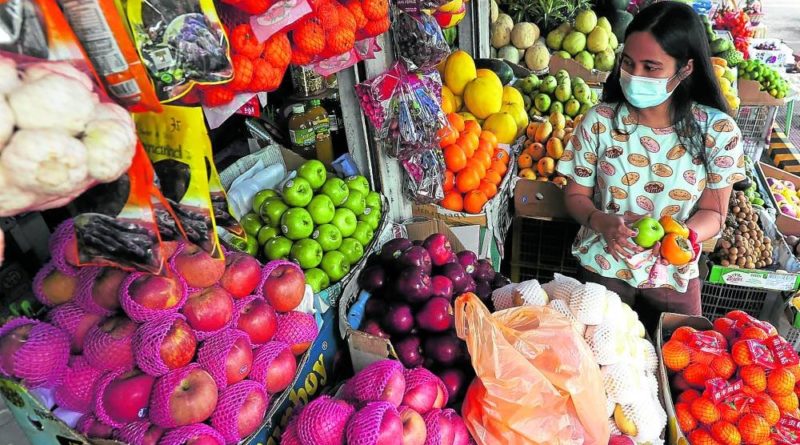HEADLINE-COVID OMICRON: MANILA- OCTA: COVID reproduction number in Metro rising
GO ROUND A vendor arranges round-shaped fruits at the San Andres market in Manila, which is steeped in Filipino tradition that eating 12 round fruits to welcome the New Year will bring prosperity and abundance. —MARIANNE BERMUDEZ / By: Tina G. Santos – Reporter / @santostinaINQDaily Inquirer / 05:50 AM December 27, 202
.
 PHILIPPINES COVID-19 OUTBREAK (as of 12-25-21 )
PHILIPPINES COVID-19 OUTBREAK (as of 12-25-21 )
Independent research group OCTA reported on Sunday that the COVID-19 reproduction number in the National Capital Region (NCR) had nearly doubled.
The country’s COVID-19 positivity rate also went up for the fourth straight day, reaching 2 percent with Metro Manila once again recording most of the 433 new infections, based on data from the Department of Health (DOH).
In a Twitter post, OCTA Research fellow Dr. Guido David said that the reproduction number in Metro Manila had increased to 0.70 as of Dec. 22, from 0.42 on Dec. 15.
The reproduction number refers to the average number of persons who can be potentially infected. Less than one indicates that transmission is slowing down.
“If we compare this with last year, the reproduction number also spiked before the holidays, followed by a dip during the holidays (probably due to many people going to the provinces for the holiday break) and then an uptick by the first week of January 2021,” David said.
SPACE RESERVE FOR ADVERTISEMENT
/
Holiday effect
“The holiday uptick may explain the increasing reproduction number and positivity rate,” he added.
The positivity rate—a measure of the spread of the coronavirus in a given area—refers to the percentage of people found positive out of the total number who underwent testing during a certain period.
At the same time, David said that a continued increase in the reproduction number during the holidays would indicate a pattern not observed in December last year.
“The reproduction number in the NCR based on testing has also increased to 0.79, which is a more accurate measure of the reproduction number because it is not affected by backlog,” he added.
He advised the public to continue to observe COVID-19 safety protocols as they celebrate the holidays.
“Whatever the case may be, we must continue to be vigilant and practice minimum public health standards as we enjoy the rest of the holidays. People with cold symptoms should be mindful of mingling with other people,” David said.
_________________________________________

SPACE RESERVE FOR ADVERTISEMENT
Ads by: Memento Maxima Digital Marketing @[email protected]
__________________________________________

/
Higher positivity rate
In its case bulletin on Sunday, the DOH reported a higher positivity rate of 2 percent—from 1.6 percent on Saturday—based on the 21,116 people who were tested on Friday.
Both rates, however, were still within the benchmark of 5 percent set by the World Health Organization.
On Friday, the DOH recorded a positivity rate of 1.4 percent, up from 1.1 percent a day before.
Based on the Sunday bulletin, the country logged 433 new COVID-19 cases, bringing the total to 2,838,640 since the start of the pandemic. Eight laboratories, however, failed to submit their data.
Of the 433 new infections, 392 cases, or 91 percent, had been recorded in the last two weeks, with Metro Manila accounting for the biggest number of cases at 192, followed by Calabarzon (Cavite, Laguna, Batangas, Rizal and Quezon) and Central Luzon.
There were 9,522 active cases, of which 3,574 were mild; 458 were asymptomatic; 3,339, moderate; 1,777, severe; and 374, critical.
The DOH also reported 283 recoveries, which brought the total number of survivors to 2,777,918.
But 13 more people died of COVID-19, pushing the death toll to 51,200.
There were only five fatalities this month, while the rest were reported between March and October, the DOH said.










